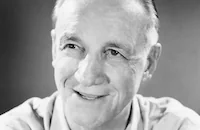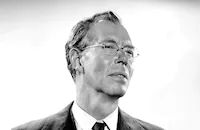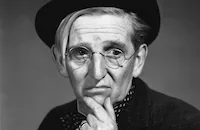Look Who's Laughing

Brief Synopsis
Cast & Crew
Allan Dwan
Edgar Bergen
Charlie Mccarthy
Jim Jordan
Marian Jordan
Lucille Ball
Film Details
Technical Specs

Synopsis
After completing his last radio broadcast of the season, ventriloquist Edgar Bergen hosts an engagement party for his assistant, Julie Patterson, and business manager Jerry Wood. The next day, Edgar and his dummy, Charlie McCarthy, leave for their summer vacation aboard Edgar's new plane. En route, Edgar, who is piloting the craft, becomes lost and lands in Wistful Vista, the home of Fibber and Molly McGee. Fibber is hurrying to a meeting of the Chamber of Commerce where, as president of the organization, he wants to propose that the town try to sell its airstrip to the Horton Aircraft factory. Fibber is opposed by Throckmorton P. Gildersleeve, who is bidding to buy the strip for a friend. The meeting is disrupted by the arrival of Edgar's plane, and the group, believing the aircraft is carrying Hilary Horton, the owner of Horton Aircraft, drives to the airstrip. There Edgar and Charlie are welcomed by Fibber and Molly, who invite them to stay at their house. Learning of Fibber's plans, Edgar offers to convince Hilary, his friend, to build his factory at Wistful Vista. When Edgar invites Hilary to visit the town on Wednesday, Gildersleeve tricks Fibber into paying for an elaborate luncheon to honor their guest. Gildersleeve is secretly working for Sam Cudahy of Ironton Realty, who wants the Horton factory built in Ironton. When Gildersleeve tries to renege on his deal, Cudahy threatens to blackmail him unless he sabotages Wistful Vista's bid for the factory. Soon after, Gildersleeve learns that Charlie wants to leave town and suggests that he send a fake telegram to Edgar, informing him that Julie is ill. On the day that Edgar is to deliver Hilary, he receives the wire and flies back to New York. Upon discovering that Julie is well, Edgar hurries back to Wistful Vista with a protesting Julie in tow. After arriving in town, Edgar learns that Fibber, humiliated, has resigned from the Chamber of Commerce and has been notified that his house is in foreclosure and the airstrip has been purchased by Cudahy. Meanwhile, Jerry and Marge, Julie's replacement as Edgar's assistant and Jerry's former fiancée, drive through the countryside in search of Julie. Back at the McGees', Charlie tells Julie that Gildersleeve suggested sending the telegram, prompting Julie to devise a scheme involving some worthless property that Gildersleeve sold to Fibber. Posing as a Horton employee, Julie tells Cudahy that her employer is really interested in buying Fibber's land for his factory. Soon after, Gildersleeve visits Fibber and offers to trade him his land for the airstrip. With the ownership of the airstrip back in Wistful Vista, Edgar convinces Hilary to fly into town. Meanwhile, Jerry and Marge have decided that they are still in love and get married. Back at the McGees', Molly discovers that Julie is in love with Edgar and advises her to "sabotage" him into marriage. They all then drive to the airstrip to meet Hilary, and as Fibber and Molly wait in Edgar's plane, Edgar and Julie greet Jerry and Marge, who have just driven into town. When Fibber accidentally takes off, Julie and Edgar follow in another plane. After Fibber nearly crashes into his plane, Hilary decides to land in Ironton. Edgar then climbs aboard Fibber's craft, and after safely landing, they all return to the McGee house, where Jerry and Marge announce their marriage. At that moment, Hilary arrives and informs Edgar that he owns a controlling interest in the Horton company and can build a factory wherever he desires. With Fibber's good name restored, Julie embraces Edgar.

Director

Allan Dwan
Cast

Edgar Bergen
Charlie Mccarthy

Jim Jordan

Marian Jordan

Lucille Ball
Lee Bonnell
Dorothy Lovett

Harold Peary
Isabel Randolph

Walter Baldwin

Neil Hamilton

Charles Halton
Harlow Wilcox
Spencer Charters
Jed Prouty
George Cleveland
Sara Berner

Sterling Holloway
Florence Wright

Charles Lane
Edna Holland
Dell Henderson
Jac George
Eddie Parker
James Farley
Matty Kemp

Louise Currie
Chester Clute
Dot Farley
Marjorie Wood
Louis Payne
Joe Hickey

James Conlin
Vic Potel
Tom Fadden
George Chandler
William Blees
Reed Hadley
Dorothy Lloyd
Bill Thompson
Donald Kerr
Sally Cairns
Eleanor Counts
Yvonne Chenal
Crew
C. Bakaleinikoff
John L. Cass
Edward Donahue
Allan Dwan
Al Herman
James V. Kern
Dorothy Kingsley
Zeno Klinker
Leonard L. Levinson
Van Nest Polglase
Don Quinn
Frank Redman
Edward Stevenson
Sherman Todd
Vernon L. Walker
Roy Webb

Film Details
Technical Specs

Articles
Look Who's Laughing

Look Who's Laughing
Quotes
What fools we morons be.- Rusty
Marriage is a strong institution, Charlie.- Julie Patterson
So is Alcatraz, but I wouldn't want to live there.- Charlie McCarthy
I'll knock his face so far down into his Oxfords that they'll call him puss in boots.- Fibber McGee
Just like eating lettuce nothing to it- Fibber McGee
Trivia
This movie was the most profitable RKO production for 1941.
Notes
The working title of this film was Look Who's Talking. In the film's opening credits, the two "O's" in the word "look" become eyeballs and the "O" in the word "who" turns into a laughing mouth. Although the characters of "Fibber McGee and Molly" are identified as Jim and Marian Jordan in the end credits, in the opening credits they are identified only as "Fibber McGee and Molly." According to a pre-production news item in Hollywood Reporter, David Hempstead was originally slated to produce this picture, but decided to remain in New York to work with Ben Hecht on the screenplay for Journey Into Fear instead. An early Hollywood Reporter production chart adds Irving Bacon and Chester Clute to the cast, but their participation in the final film has not been confirmed. Although actor Bill Thompson is listed in the CBCS in two different parts, it has not been confirmed that he played two different roles. Another pre-production news item in Hollywood Reporter adds that although the studio originally designated the film as a medium budget production to attract radio listeners, it later decided to raise the budget to a big-scale production. According to that news item, Desi Arnaz was to star in the cast with Lucille Ball. The film was described in the Hollywood Reporter review as a "collaboration between the radio comedians' gag writers and screenwrtier James Kern." A Hollywood Reporter news item published after the film's release noted that this was the most profitable RKO production of 1941, and its success prompted the studio to sign more radio personalities.














